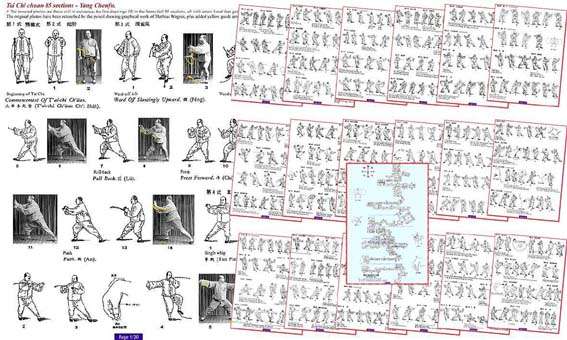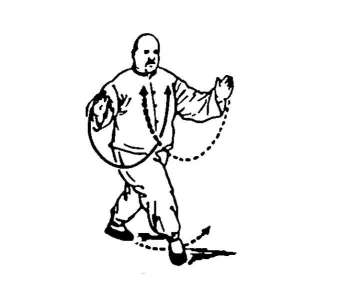|
|
The TAI CHI CHUAN of Yang ChengFu (85 section long form)

# For people wishing to learn long Tai Chi...
The full set of 85 sections of the Tai Chi form, known as 'long Tai Chi', is illustrated in our printable 20 page PDF file, see the abstract shown below for more details.
Anyone with perseverance & concentration can self teach themselves the relaxing form of Tai Chi. It may take a year or so to learn really well, but this 'long form' is not for rapid progress - but is suited for steady & stable increase. Cross referencing with other practisers is encouraged, as this will help with insight into the Chi awakening process & from the doing of the form.
A great many different versions of the 'Long' & 'Short' form Tai Chi exist nowadays. This one (the 85 Section form) has the proofs of showing the original movements of Yang ChengFu, in its inserted photos on the first page of our PDF. For the existing remaining set of these photos, now retouched as pencil drawings - see the work of Mathias Wagner who did the photo retouching at http://www.qigong-baden-baden.de/Yang-Chengfu-en.html
Also now available is the published book from 1931; 'Methods of applying Taiji Boxing - Taiji Quan Shiyong Fa - Yang ChengFu', for a copy of the book in English with Chinese sections & the old original photographs, see the website at https://brennantranslation.wordpress.com
HERE ARE SOME IMAGES FROM OUR PDF (downloadable) FILE:

Some detail from the 1st few drawings on page 1. Here you can see just how easy it is to follow the postures (standing etc) and the guide arrows for each limb - on each figure. TRY IT OUT NOW - USING A SLOW CONTINUOUS MOVEMENT? See how the arrow guidelines lead to the next pictures hand/foot positions, this method guides the learner of the form through all 85 sections. These are the introductory movements for the beginning of the 85 section Long Tai Chi.
In all there are 19 pages of these figures to learn until the end of the form. Page 20 is a map of the required footwork with compass directions. In many ways this "by pictures" method of learning is quicker & easier than by using a video, as you can at a glance study the detail of every movement (right down to a flexed-foot or turning the foot outward), plus easily see ahead or go back.
THIS NEXT IMAGE SHOWS ALL THE INSTRUCTION SHEETS AVAILABLE IN THE PDF FILE:

Teach yourself and find the happiness and release from doing this energizing form. You can buy this 20 page set at just AUD$10.00 for a downloadable PDF file copy. This price is about the same as getting 20 A4 photocopies from your local photocopy shop, which we assure you is very cheap, considering the amount of hours of graphics and computer work done compiling these pages.
Ornasonova trades via Paypal or by using a credit card for this transaction. After your payment is confirmed, we then email you with the download details. We will need your Name, Email & Address details to reply to you & for our sales records. Choose the 'Add To Cart' button and 'View Cart/Checkout' buttons below to get your copy.
| Cart Items: 0 Total: $0.00 |
--
HOW MUCH FLOOR SPACE IS USED TO DO THE COMPLETE FORM?
Some Web search notes:
'The long form uses an open space about 20' x 10'.'
'How much room to practice Tai Chi? 8 X 3 meters (26' x 10') is enough for most forms of Tai Chi.'
--
By using the following calculation method it is necessary to know the 'Flexed-Foot' step measurement, the rest can be multiplied from this.

|

|
Anyone from a child to an adult, short or tall, can measure their 'short-step'.
Notice in the 2 images (see left), the foot that has the standing weight is bent slightly
at the knee in a comfortable, unstrained way. The outstretched front leg,
doesn't disturb the standing stance on the rear leg, but firstly rests its
heel on the ground, then flattens the foot to the ground. |
For a width answer in C. A in cm is your step measurement, multiply by B for width is 3
For a length answer in C. A in cm is your step measurement, multiply by B for width is 7.5
For the floor space width: .74 * 3
For the floor space length: .74 * 7.5
Compared to the measures found on the web, noted above, you can see a more exact calculated measure that is needed for your own height.
# For short or tall people, the resulting meter wide & long measures will differ.
Mine are as follows, with a height of 5' 9" & a short-step of 2' 5" or 74 cm.
Making my ideal area for Yang Style Long Form (85 forms) Tai Chi, 5.5 mtr x 2.25 mtr. With this much floor-space empty, doing the form on it will run its full course, that includes with a few of the forms kicking the leg at side angles, & a few of the forms stepping & striking at side angles. Plus by these calculations, with stepping as shown in the 85 forms images, the doing of the whole-form will end on the same position as when it started.
### This pointer, is an exact indicator that the form was done correctly.
--
ANIMATED HELP SEQUENCES ILLUSTRATED FROM THE MAIN 85 SECTIONS.

| These deal with the particular parts of Tai Chi that need some special attention. The basis of doing Tai Chi actions slowly, is to get the benefit of chi flowing from 'Tai Chi' training, but here these kick & turn sequences are done at more normal or even fast speed. It is impossible to do these particular actions at the slow Tai Chi speed, some momentum being necessary to carry one through the spins and swing movements. |
(Its like; "What you put into a movement energy-wise, is what you get out", excess or insufficiency would produce imbalance). Success in Tai Chi is not just in awakening the chi flow in the body, but also in achieving deeper control of the bodies functioning.
So, bear in mind that a benefit of doing Tai Chi, is that it will teach the actions of quarter turning, half turning and complete circle turning, as one makes progress through the whole of the form. The following short animated sections (below) relate to these more advanced sequences. The degree of difficulty is in stages, with the more difficult being the last sequence at section 80 to 82, this is toward the end of the whole form, as ones abilities excel. Simply click on the relevant sequence you need help for below.
Section 42 up to Section 44
Section 80 up to Section 81
NOTE ON FUTURE STUDY: After completion of the forward form, plus the experience of a number of years of practise, its possible to learn to do this form reversed. Its benefits help even out the irregularity of predominant right handedness (overuse syndrome). A series of these reverse forms (19 set) is available for advanced practitioners, this special form set serves as a guideline only, or it may be found that vivid use of mind & recall proves sufficient.
Copyright © 1979-2025 Ornasonova. All rights reserved.
Section 42 up to Section 44
Section 80 up to Section 81
Page Top | Contact
Section 31 up to Section 33
Section 80 up to Section 81
Page Top | Contact
Section 31-9 up to Section 33-2
Section 42 up to Section 44
Home Page | Page Top | Contact

Last webpage update: July 2023


